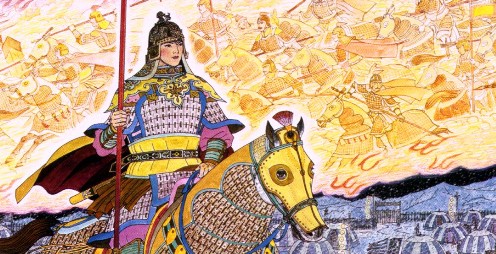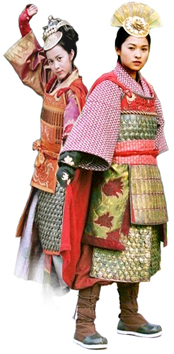|
Women Warriors' Secret
by Jasper Becker
South China Morning Post
Chinese archaeologists are arguing about the discovery of hundreds of terracotta women warriors found guarding the tomb of the Emperor Jingdi and his wife, Empress Wang of the Western Han Dynasty.
It is the first time that female warriors have been found and these are armed and mounted on horseback as if riding in cavalry formation.
They differ in other respects from the male terracotta warriors who guard the tombs of the Qin Emperor. The figures are about a third the size of human beings and have been found painted but naked and without arms. Their garments of silk and hemp and their wooden movable arms have rotted away during the past 2,000 years.
At the tomb of the Emperor Jingdi (206BC-AD24), which lies not faraway at Xianyang in Shaanxi province, archaeologists have found 90 pits with 600 terracotta cavalry and foot soldiers as well as livestock, work tools and many wooden chariots.
Although the female warriors were found five years ago, the discovery has been given little publicity. Archaeologists are still arguing about their meaning.
Xu Pingfang of the Institute of Archaeology insists the women do not represent genuine warriors but formed part of a ceremonial procession.
"They are certainly the oldest female terracotta figures found in any tombs in China. In Qin dynasty tombs we have found no females at all," Mr Xu said.
He also believes Qin Shi Huang's terracotta warriors were also ceremonial guards and do not represent real fighters.
The leader of the archaeological team, Wang Xueli, is certain that this is a period when women took part in battles. He says the figures are unmistakably made to show their sex. They are armed and in a military formation.
They have well-defined features including sexual organs and belly buttons and are dressed in real garments unlike the Qin figures who have painted-on clothes.
Journalist Zhou Xiaoxue who has just come back from visiting them says they are not made to look like servants or a troupe chosen for ceremonial purposes.
"If that was the case they should be pretty but they all look quite tough with high cheekbones. They even look a little wrinkled. They are certainly not pretty," she said.
Chinese historians believe that in the Han Dynasty which followed the collapse of the Qin empire, the status of women changed considerably. The equality between the sexes only changed dramatically during the Song Dynasty (960-1279) when foot-binding was first introduced.
|
|





